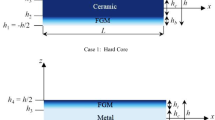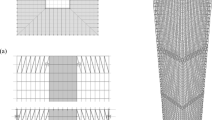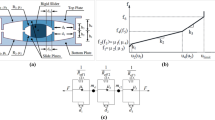Abstract
The dynamic behaviour of parachutes is highly complex and characterised by non-linear, time-dependant, Fluid–Structure Interactions, which is computationally intensive and hence not a viable option for incorporating into trajectory simulations. The paper describes modelling of a “Computationally efficient, High Fidelity Multi-Body” Parachute–Elastic Riser–Payload system, capable of simulating trajectory from parachute deployment to parachute separation. The matrix form of Kane’s method is used to derive the kinematic and dynamic equations of motion for the system, which avoids the complications of symbolically deriving these equations. The developed model is validated with published literature results formulated using the Newton–Euler method and simulation results describing the typical trajectory and attitude of the system during the descent phase are presented.












Similar content being viewed by others
References
Duan, S.S.: A comparsion case study of dynamics analysis methods used in applied multibody dynamics, American Society for Engineering Education, 2006–1859 (2006)
Fallon, E.J.: Parachute dynamics and stability analysis of the queen match recovery system, AIAA Paper 91-0879 (1991) https://doi.org/10.2514/6.1991-879. https://arc.aiaa.org/doi/abs/10.2514/6.1991-879
Ge, Z.M., Cheng, Y.H.: Extended kanes equations for non-holonomic variable mass system. J. Appl. Mech. 49(2), 429–431 (1982). https://doi.org/10.1115/1.3162105
Guglieri, G.: Parachute-payload System Flight dynamics and trajectory simulation. Int. J. Aerosp. Eng. 2012, Article ID 182907 (2012). https://doi.org/10.1155/2012/182907
Heinrich, H.G., Eckstrom, D.J.: Velocity distribution in the wake of bodies of revolution based on drag coefficient. Air Force Flight Dynamics Laboratory Report ASD TDR-62-1103 (1963)
Henderson, D.: Euler angles, quaternions, and transformation matrices – Working relationships. National Aeronautics and Space Administration, Mission Planning and Analysis Division, Washington DC (1977)
Hurtado, J.E.: Analytical dynamics of variable-mass systems. J. Guid. Control Dyn. 41(3), 701–709 (2017). https://doi.org/10.2514/1.G002917
Ibrahim, S.K., Engdahl, R.A.: Parachute dynamics and stability analysis NASA-CR-120326 (1974)
Kane, T.R., Levinson, D.A.: Dynamics, Theory and Applications. McGraw-Hill, New York (1985)
Ke, P., Yang, C., Sun, X., Yang, S.: Novel algorithm for simulating the general parachute-payload system: theory and validation. J. Aircr. 46(1), 189–197 (2009). https://doi.org/10.2514/1.34240
Kidane, B.: Parachute drag area using added mass as related to canopy geometry. In: 20th AIAA Aerodynamic Decelerator Systems Technology Conference and Seminar (2009). https://doi.org/10.2514/6.2009-2942
Pal, R.S.: Modelling of helicopter underslung dynamics using Kane’s method. 6th conference on Advances in Control and Optimization of Dynamical Systems ACODS. IFAC-PapersOnLine 53(1), 536–542 (2020). https://doi.org/10.1016/j.ifacol.2020.06.090. https://www.sciencedirect.com/science/article/pii/S2405896320301099
Paul, J., Nalluveettil, S.J., Purushothaman, P., Premdas, M.: Combined Body Dynamics Simulation of Crew Module with Parachutes, 10th National Symposium and Exhibition on Aerospace and Related Mechanisms (2016)
Pei, J., Roithmayr, C.M., Barton, R.L., Matz, D.A.: Modal Analysis of a Two-Parachute System, 25th Aerodynamic Decelerator Conference. AIAA, Washington (2019)
Peterson, C.W., Johnson, D.W.: Reductions in parachute drag due to forebody wake effects. J. Aircr. 20(1), 42–49 (1983). https://doi.org/10.2514/3.44826
Stoneking, E.: Implementation of Kane’s method for a spacecraft composed of multiple rigid bodies, AIAA Guidance, Navigation (2013). And Control (GNC) Conference. https://doi.org/10.2514/6.2013-4649, https://arc.aiaa.org/doi/abs/10.2514/6.2013-4649
Author information
Authors and Affiliations
Contributions
The author (Iyer, Prashant G) confirms sole responsibility for the following: development of theoretical formalism, numerical modelling of system, simulations and validation of model and formalism, analysis and interpretation of results, and manuscript preparation.
Corresponding author
Ethics declarations
Competing interests
The authors declare no competing interests.
Additional information
Publisher’s Note
Springer Nature remains neutral with regard to jurisdictional claims in published maps and institutional affiliations.
Rights and permissions
Springer Nature or its licensor (e.g. a society or other partner) holds exclusive rights to this article under a publishing agreement with the author(s) or other rightsholder(s); author self-archiving of the accepted manuscript version of this article is solely governed by the terms of such publishing agreement and applicable law.
About this article
Cite this article
Iyer, P.G. Modelling of a 12-DoF Parachute–Riser–Payload system dynamics using Kane’s method. Multibody Syst Dyn 60, 599–619 (2024). https://doi.org/10.1007/s11044-023-09939-z
Received:
Accepted:
Published:
Issue Date:
DOI: https://doi.org/10.1007/s11044-023-09939-z




